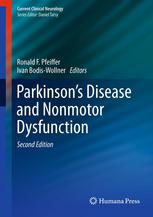

Most ebook files are in PDF format, so you can easily read them using various software such as Foxit Reader or directly on the Google Chrome browser.
Some ebook files are released by publishers in other formats such as .awz, .mobi, .epub, .fb2, etc. You may need to install specific software to read these formats on mobile/PC, such as Calibre.
Please read the tutorial at this link: https://ebookbell.com/faq
We offer FREE conversion to the popular formats you request; however, this may take some time. Therefore, right after payment, please email us, and we will try to provide the service as quickly as possible.
For some exceptional file formats or broken links (if any), please refrain from opening any disputes. Instead, email us first, and we will try to assist within a maximum of 6 hours.
EbookBell Team

4.0
66 reviewsThe first edition of Parkinson’s Disease and Nonmotor Dysfunction was published in 2005 to provide a source of detailed information that could be readily accessed by the practicing physician. The widely praised first edition described and explained these nonmotor features that had at that point received insufficient attention both in the medical and in the lay literature. Since the publication of the first edition, awareness and knowledge of the nonmotor features of PD has dramatically expanded, calling for a new edition of this important title. Timely, fully updated and expanded, Parkinson’s Disease and Nonmotor Dysfunction, Second Edition, offers a state-of-the-art overview of the topic from the same talented group of experienced researchers and clinicians who were the driving force behind the first edition. Importantly, a range of additional aspects of nonmotor dysfunction in PD -- such as dermatological, vestibular, and dental dysfunction -- have been included in this second edition, which remains subdivided into five diverse domains: Behavioral abnormalities, autonomic dysfunction, sleep-related dysfunction, sensory dysfunction, and other aspects of PD such as oculomotor dysfunction, fatigue, and maxillofacial issues. An invaluable contribution to the literature in movement disorders, this revised and expanded collection of contributions by an even larger contingent of superbly knowledgeable authors will further increase awareness of the manifold contributions that nonmotor features may make to the collective clinical picture experienced by the patient with PD.